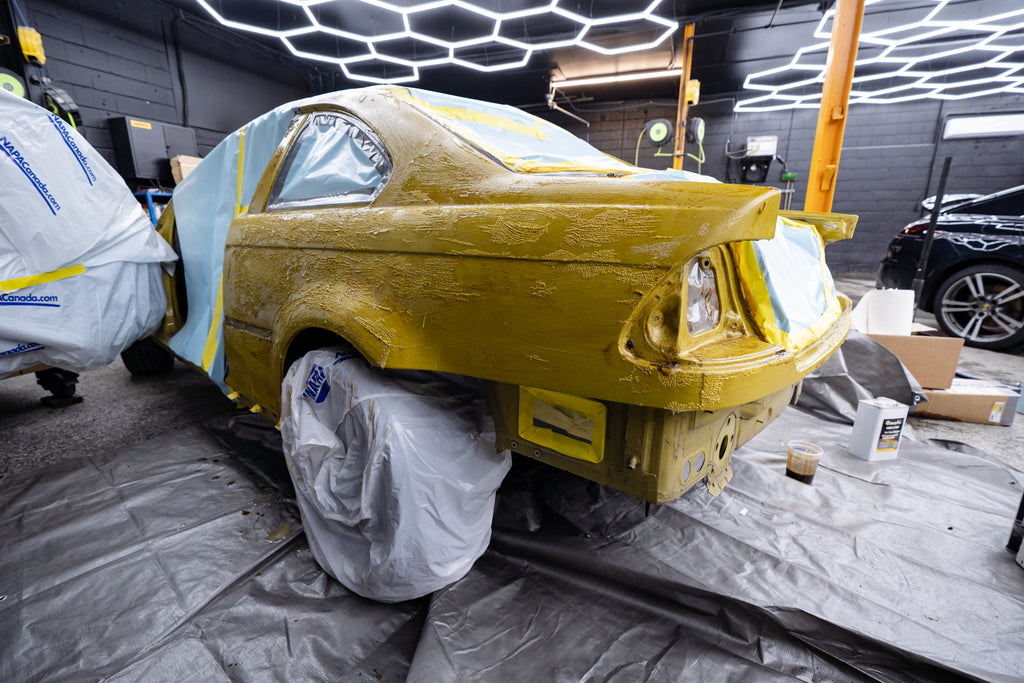Striptease.

"In this Special Series, I document my complete paint & body restoration along with the exterior upgrades to CSL specifications.
In this entry, it's time to strip.
It isn't as sexy as it sounds: harsh chemicals, a lot of scrubbing, some sanding, a lot of patience and we might be in for surprises when everything's off. The end game is worth it: it's a body reset."
-Matt
The ghost in the shell.
Many E46 M3 owners are now reaching the point of no-return: the cars are valued, but they are old.
They aren't what we tout them as, neither what the journalists claimed in the 2000s. These cars have history: it's not always pretty, neither it is known.
Most M owners experiences with paint & bodies are either insurance claims, front end refreshes and aftermarket body panel paint matching. None of these are intensive from a paint & body perspective. Some sanding and we're off to the spray booth.
My original Stripper got its entire front end refreshed, along with the side skirts. It's a 2012 and had seen a single winter. I wanted its paint perfect, and protected with PPF.

A true reset: the stripping process.
In the entry covering the initial game plan, we asked the key question. We kept a fundamental part of the answer to this journal entry.
The stripping process is to be taken literally: a true restoration requires stripping the car down to its bare metal. It's the closest thing to a factory effort starting from its original metal shell.
There are a few techniques to go about it. It will depending on your body shop's preferences, local regulations and their willingness to get stained.
We went with the chemical route: using aircraft paint stripper and a lot of man hours.

This sh*t stains everything.
Always read the precautions. These chemicals are extremely harsh.
The team masked off any surface area you don't want stripped to its carbon essence is mandatory. Protecting your eyes, hands and skin comes first.
They laid down large plastic sheeting to protect the epoxy shop floor, masked the interior and covered the wheels and tires.

Luigi and co went to work applying the stripping agent by brushing it across the entire shell.

The process requires an even application, but it isn't exactly obvious where you apply the chemicals at first.
Once the first coats were brushed on, the team wrapped the car in masking sheets to contain the chemicals and increase their effectiveness.

Chemicals have a half life: they will evaporate in some form, in some time. Keeping those vapours by the paint accelerates the process.
An hour passes, approximately - and they took the suit off. The wrinkles of death appear.

The chemicals went to work and wrinkled the Phoenix Yellow paint and clear coat across the shell.

PY was Booger Yellow for a minute.

The chemicals aren't enough on their own. Mechanical actions are required to get the paint off. Fancy way of saying scrub, you scrub.

In all seriousness, shoutout to Luigi for the eternal patience in doing the dirty work. This is painstaking.
You don't exactly know how well you brush off the chemicals, nor how hard the clear coat, or how thick the paint was.
Another pass was required - more scrubbing.

Luigi & co were done scrubbing when they reached this approximate stage. The chemical stripping process remains brute force.

It's a bulk effort to get 90% there - but 100% is the goal.
Friction to end it.
The intention with paint stripping is to start from scratch like the Factory did. Some scratches were needed, it was time to take the sanding papers and dustless machines out.
Luigi the relentless.

Luigi was kind enough to answer my 1000 and 1 questions about the process. For these guys, it's standard procedure.

This is where it ends for PY.
Luigi pointed to an area he freshly sanded to show when it ends for the sanding portion of the shell stripping process.
The white'r section indicates bare metal.
Stripping down a shell to bare metal is a costly endeavour, and it can get costlier. You never know what you're going to find.

We couldn't find any bondo nor excessive dings on any sections of the shell.

We sanded down and bondo'ed a very small section by the door sills that showed rust. Considering this is a Quebec car where we go from -40C to +40C, this is exceptional.

The trunk area where rain regularly leaks into was perfectly clean.

The ghost redeems itself.
I've long stated this car was shortly for the junkyard when I bought it: the interior was done for, the paint was crap and the car was barely running.
The previous owner didn't care much, he wanted a boat instead. He did deserve a little credit on this one: the car barely saw Winter during its lifetime.
Circa September 2021. The colors of Fall, it's a unique beauty to the North East.

Up next: it's Showtime.We spray her first coats.
We talk primers, and a myriad of sanding techniques to get a perfectly flat panel to truly begin laying down its new colors.










